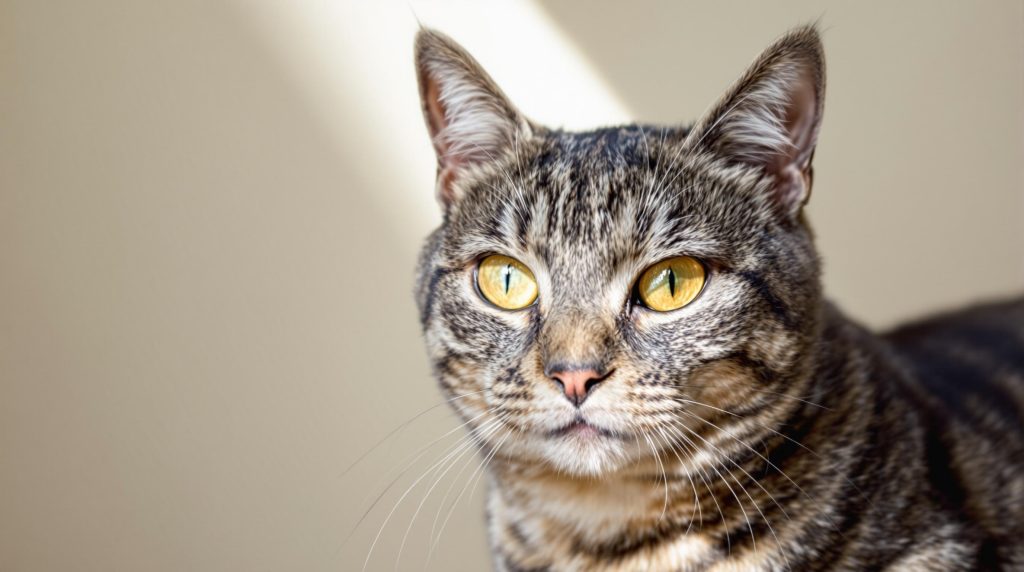Understanding Nonverbal Communication in Cats: Signals and Meanings

The Language of Cats: Understanding Feline Signals
Cats, often regarded as mysterious companions, communicate primarily through their body language and subtle cues, making their nonverbal communication a significant area of interest for pet owners. Unlike human verbal communication, where words convey meaning, cats utilize a rich tapestry of gestures, postures, and expressions. By learning to interpret these signals, cat owners can significantly enhance their relationship with their feline friends, fostering a deeper connection and a more harmonious household.
Firstly, one of the most telling aspects of feline communication is the tail position. A tail held high typically reflects a cat that is both happy and confident. Conversely, a low or puffed tail not only suggests fear but can also be a sign of aggression or readiness to defend itself. Observing this behavioral signal can help an owner gauge whether their cat is feeling secure in its environment or is anxious about impending interactions, whether with humans or other animals.
Another crucial aspect pertains to ear movement. Cats have remarkable control over their ears, which can pivot to capture sound from various directions. Ears facing forward can signal curiosity; the cat is actively exploring its surroundings. However, when a cat’s ears are flattened against its head, it may reveal discomfort or annoyance, potentially indicating that the cat feels threatened. Cat owners in Nigeria, where local wildlife may sometimes intrude into homes, would benefit greatly from understanding these signals, as they can indicate when to intervene to ensure the well-being of the cat.
Facial expressions also carry a wealth of meaning. A cat that frequently engages in slow blinking is likely expressing trust and affection—a behavior that cat owners can reciprocate by gently blinking back, which can strengthen the bond. On the flip side, dilated pupils can suggest a heightened state of excitement or fear, signaling caution for the owner when interacting with their pet. Recognizing these emotional indicators can be vital in safeguarding both the cat’s well-being and the safety of its surroundings, particularly in community settings where cats may encounter other animals or unfamiliar faces.
By developing awareness around these nuances of feline nonverbal communication, cat owners can foster a deeper emotional understanding of their pets. This knowledge is especially important in Nigeria, where cats can serve both as pets and symbols of cultural significance in various communities. As you delve deeper into the world of feline signals, you will not only enjoy your relationship with your furry companion more but will also ensure they feel safe and understood in your home.

In conclusion, interpreting your cat’s behavior can unlock a treasure trove of insight into their emotional landscape. By exploring these intricate behaviors, you can become better equipped to respond to their needs, ultimately leading to a more enriching companionship.
CHECK OUT: Click here to explore more
Decoding Feline Body Language
Understanding your cat’s nonverbal communication is key to fostering a positive and fulfilling relationship. While cats may not speak our language, they certainly have ways of expressing their needs and emotions through their physical movements and positions. By paying close attention to these signals, cat owners can better respond to their pets’ emotional states and create a safe environment for them to thrive.
One fundamental element of feline body language is posture. A cat’s stance can indicate a variety of feelings, including relaxation, tension, and aggression. For instance, a relaxed cat will often have its body stretched out, lying with its paws tucked under or sprawled comfortably. Conversely, a cat that is hunched over, with its tail curled around its body, may be feeling threatened or insecure. Recognizing the distinction between these postures can enhance an owner’s ability to read their cat’s mood and respond accordingly.
Listed below are some common postures to observe in cats:
- Relaxed Posture: Body loose, tail extended comfortably behind, head held high.
- Defensive Posture: Back arched, fur puffed up, tail elevated or curled tightly.
- Playful Posture: Forelegs bent, rear end in the air, with tail waving enthusiastically.
- Submissive Posture: Lying on back, exposing belly, signaling trust and vulnerability.
In addition to posture, another vital aspect of nonverbal communication in cats is vocalization. Although this may seem more verbal than nonverbal, cats often use sounds in conjunction with their physical language. A soft purr accompanied by a relaxed body usually indicates contentment, while a loud hiss or growl, combined with a defensive posture, clearly suggests a cat that feels threatened. Cat owners need to be attuned to these sounds in relation to their cats’ body language to effectively interpret their mood and intentions.
The whiskers of a cat also play a crucial role in conveying emotion and intent. They act as sensory tools that help cats gauge their surroundings. When whiskers are pointed forward, it often reflects curiosity, suggesting that the cat is intrigued by something nearby. However, whiskers that are pulled back against the face can suggest stress or discomfort. Being observant of these signals can provide insight into a cat’s interactions with the environment and other animals, which is critical in multicultural settings like Nigeria, where various wildlife may pose challenges.
As you begin to explore the intricate world of feline nonverbal communication, you may discover that understanding these signals not only improves your relationship with your cat but also ensures a tranquil and harmonious home environment. With each subtle gesture revealing the underlying emotions, cat owners can continuously learn and adapt their interactions to better suit their feline compatriots.
| Signal Category | Interpretation |
|---|---|
| Body Posture | A cat’s posture, whether relaxed or defensive, can reveal its mood and intentions. |
| Tail Position | The position of a cat’s tail signals their emotional state; a raised tail often indicates happiness. |
| Ear Orientation | Forward-facing ears suggest curiosity and interest, while flattened ears indicate irritation or fear. |
| Eye Contact | Prolonged eye contact can signify affection, whereas a quick glance might indicate caution. |
Understanding these signals provides insightful revelations into a cat’s temperament and needs, fostering stronger bonds between humans and their feline companions. With keen observation, cat owners can interpret nonverbal cues, enhancing the overall wellbeing of their pets. Discovering the nuanced language of cats not only enriches the owner-pet relationship but allows for more effective communication, resulting in a more harmonious home environment. By paying attention to these key behaviors, enthusiasts can further delve into the fascinating world of cat communication, uncovering the depths of their feline friends’ emotions and intentions.
CHECK OUT: Click here to explore more
Recognizing Feline Facial Expressions
Felines are often dubbed as creatures of mystery, but their facial expressions can offer a fascinating window into their emotional world. Just like humans, cats express a range of feelings through their facial features. Understanding these expressions can be crucial for cat owners, especially in contexts such as shared living spaces, where harmonious cohabitation with multiple pets is vital. Recognizing when a cat is agitated or contented can help prevent conflicts and promote a peaceful environment.
One prominent feature to observe is eye contact. Cats have a unique way of communicating through their eyes. A slow blink, often termed as a “cat kiss,” can indicate affection and trust. When a cat gazes at you and then slowly closes its eyes, it is a sign that they feel safe and relaxed around you. Conversely, dilated pupils can be a sign of excitement or fear, particularly if paired with a tense body posture. This is particularly relevant in Nigeria’s bustling urban settings, where unexpected noises might startle a cat, manifesting in this distinctive eye reaction.
The ears of a cat also serve as indicators of emotional states. Ears pointed forward generally signal curiosity or interest, while ears that are flattened against the head usually suggest feeling threatened or angry. Understanding these signals can help you preempt potential conflicts between your cat and other animals or even humans. For instance, when visiting friends or family with your cat, observing their ear position can help you gauge whether they are feeling at ease or stressed.
Moreover, the positioning of a cat’s mouth can reveal much about how they are feeling. A cat that has its mouth slightly open and the whiskers positioned forward may be intrigued or smelling something interesting. In contrast, a tightly closed mouth, accompanied by a focused expression, can indicate that the cat is feeling assertive, possibly ready to defend its territory. As Nigerian cultural settings vary widely—rural areas may host different wildlife than what one experiences in urban locales—being aware of these expressions can help cat owners better manage encounters with local wildlife.
Another fascinating component of feline nonverbal communication is the tail. A cat’s tail is a powerful indicator of mood and intention. An elevated tail typically signifies a confident and happy cat, while a low or tucked tail can indicate fear or submission. An excited, swishing tail can be a sign that the cat is ready to play, while slow, deliberate movements may suggest a cat that is feeling calm and collected. Observing these tail signals can help owners determine whether to engage in play or give their cat space, thereby respecting their emotional well-being.
s you delve deeper into understanding the nuances of feline nonverbal communication, it becomes increasingly clear how crucial these indicators are in fostering a secure and loving environment for your pet. Each micro-expression and movement can communicate a novel arc of your cat’s feelings, leading to richer, more meaningful interactions. With a little practice, you can enhance your ability to read your cat’s emotions, transforming the way you connect with your furry companion.
ADDITIONAL INSIGHTS: Expand your understanding here
Conclusion: The Art of Feline Nonverbal Communication
In the intricate world of feline nonverbal communication, understanding the myriad of signals and meanings is key to strengthening the bond between cats and their humans. The subtle nuances of a cat’s facial expressions, the position of their ears, the movements of their tail, and the depth of their eye contact can unlock a treasure trove of emotions that inform their needs, feelings, and intentions. As cat owners in Nigeria navigate the unique environments of urban and rural living, recognizing these signals can be crucial in ensuring their pets thrive in a secure and comforting atmosphere.
Moreover, this knowledge not only fosters a better understanding of individual cats but also enhances the social dynamics in multi-pet households. For instance, being aware of a cat’s body language can help mitigate conflicts during interactions with other animals. A calm environment nurtures emotional health, which is essential for pets, especially in bustling urban areas where they might face unexpected stimuli.
As individuals seek deeper connections with their pets, embracing the art of interpreting feline communication can transform relationships. Each observation brings potential enlightenment, prompting cat owners to reflect on their pet’s inner world. By investing time in learning these nonverbal cues, you can cultivate an enriched partnership with your furry friend, ultimately leading to better care and harmonious living.
In conclusion, the journey to understanding your cat’s nonverbal communication is an ongoing process, offering a rewarding path filled with discovery and connection. Unlock the mysteries hidden in your cat’s signals, and watch your relationship flourish as a result.



